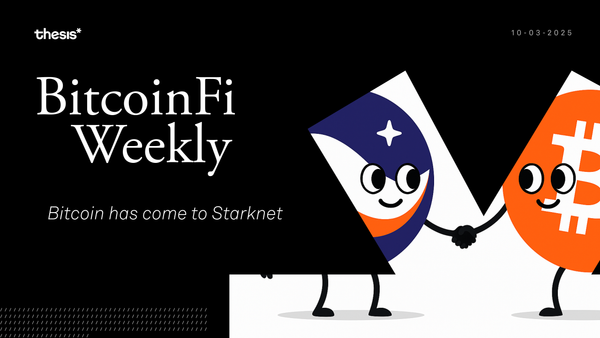Bitcoin's Moment in the Monetary Maelstrom
We've witnessed the Bank of Japan pirouette away from its tightening stance, sending ripples through the Yen carry trade that could rival a tsunami. Meanwhile, Bitcoin stands at a crossroads.

Welcome to BitcoinFi Weekly. We cover where people use their BTC and what is changing in the Bitcoin world.
Last week, we unironically wrote that we had lived many lifetimes just within the month of July. August is already proving to be no less tumultuous.
As we peter out into fall, we find ourselves in the eye of a financial storm, with central banks making moves that reverberate through the global economy. This week is a masterclass in market dynamics, political intrigue, and everything BitcoinFi. Buckle up.
Here’s this week’s rundown:
🌪️ Global Markets in Turmoil: BOJ Ends Tightening
💰 Lava: Bitcoin-Backed Loans Heat Up
🚫 Data Availability on Bitcoin: Not So Fast
🔄 Fractal: A New Approach to Bitcoin Scaling
💼 Institutional Interest: ETFs Gaining Traction
Feature Piece: Global Markets Sees Winds of Change
A confluence of events sets the stage for what could be Bitcoin's most significant moment yet. As central banks pivot and traditional financial institutions reassess their stance on cryptocurrencies, we're witnessing a paradigm shift, with Bitcoin smack dab in the center.
The Bank of Japan has just closed the curtain on its tightening cycle with a 25 basis point hike. For the first time in 17 years, the Yen carry trade—the financial equivalent of a lazy river ride—has come to an abrupt end.
The Yen carry trade is a strategy where investors borrow Japanese yen at low-interest rates to invest in higher-yielding assets elsewhere. The trade is profitable as long as the cost of borrowing remains lower than the returns on the invested assets. However, it's sensitive to changes in interest rates and currency fluctuations. When Japan raises rates, or the Yen strengthens significantly, as we've just seen, it can force a rapid unwinding of these positions, causing ripple effects across global markets. This recent unwinding has been particularly dramatic. The last time Japan did this, in February 2007, it triggered a market quake that lasted five days, bottomed out, and then took a month to recover. This time, we're already two weeks into the turbulence, and the world is holding its breath.
Globally, all eyes are on the Fed, with the market anticipating multiple rate cuts this year and next. This shift in monetary policy is tantamount to warming up the global money printers, a scenario reminiscent of the conditions that previously catalyzed Bitcoin's dramatic ascent (ie: 2008).
However, as a result of the global calamity, the crypto market saw a dramatic unwinding of leverage. Liquidations swept through like wildfire. Historically, such events often precede robust recoveries, laying the groundwork for new rallies.
We're seeing a market recalibration. The last time we observed tailwinds of this magnitude for Bitcoin was in the wake of the 2020 global monetary expansion. Then, as now, we saw a combination of expansionary monetary policy, increased retail participation fueled by stimulus checks, and the entry of prominent macro fund managers putting their TradFi weight behind Bitcoin as an investment asset, rather than a risk asset. As the Yen carry trade unwinds, the U.S. market shows resilience with a Nasdaq gap down followed by a rally. Despite its volatility, the crypto market has demonstrated its capacity to operate continuously through the crisis, handling substantial volumes while traditional markets implemented circuit breakers.
Looking ahead, the increased probability of more aggressive rate cuts could have profound implications for yield-generating strategies within crypto ecosystems. This shift may favor native yield generators over those reliant on government debt, potentially reshaping the RWA landscape. While optimism is warranted, it's tempered by several factors. The absence of high-profile institutional failures, the potential for further deleveraging, and the widespread eagerness to "buy the dip" suggest that we may not have seen the ultimate capitulation event that often marks market bottoms.
Nevertheless, the entry of long-term investors and the historical tendency for prices to rise in the month following such events provide grounds for cautious optimism. What we're witnessing may well be a transformative moment for Bitcoin and the broader cryptocurrency market.
CEX Custody is Lava
Lava, a new platform built for Bitcoin-backed stablecoin loans, made a splash with the announcement of their seed round last week.
The company aims to simplify global finance by offering a simple Bitcoin onramp via Ramp, an exchange aggregator, and USD loans secured by Bitcoin.
We strongly believe in their thesis that Bitcoin holders don’t want to spend their Bitcoin. Better ways to use Bitcoin in the real world are needed, and novel mechanisms for this future of “save in BTC, spend in dollars” are exciting to see.
Lava uses Discreet Log Contracts to create “smart contract-like” execution in a trust-minimized way. This creates a framework for the movement of funds, dependent on a certain outcome, whether liquidation, repayment, or expiration.
DLCs rely on external oracles for information to determine the outcome of events. Lava has built its own oracles called Sibyls, making the “Lava Loan” mechanism possible.
Data Availability on Bitcoin
Bitcoin blockspace is full — there isn’t room for 100s of rollups
A recent report by Galaxy Research found that posting rollup transaction data to Bitcoin is technically challenging and economically prohibitive for most projects.
The crux of the issue lies in Bitcoin's limited block space and associated costs. With blocks capped at 4MB and consistently full since January 2023, there simply isn't room for hundreds of rollups to post their data. This scarcity is starkly illustrated by the Taproot Wizards project, which paid six figures in fees to fill a single 4MB Bitcoin block. Such high costs make it unfeasible for most "Bitcoin rollups" to inscribe state data to the Bitcoin blockchain regularly.
The economics become even more challenging when we consider that on Ethereum, where data throughput is approximately ten times that of Bitcoin, 76.5% of zkSync's revenue went to ZK verification and Layer 1 call data costs. Extrapolating this to Bitcoin's more constrained environment paints a sobering picture for potential rollup projects.
Furthermore, the very definition of a rollup becomes contentious in the Bitcoin context. True rollups, as implemented on Ethereum, require that transaction data be fully accessible and implementable via the base blockchain. This allows anyone running a node to reconstruct the rollup's state. However, given Bitcoin's data scarcity and high costs, achieving this level of data availability seems impractical for most projects.
In light of these challenges, it's becoming clear that the term "Bitcoin rollup" may be more marketing jargon than technical reality for many projects. The economic realities suggest that only a select few, if any, will be able to use Bitcoin's blockspace for their transaction data in a true rollup fashion.
Stay in your lane with Fractal
Fractal is a new protocol that doesn’t fit into the “hot new L2” category. Instead, they claim to build unlimited layers on top of Bitcoin to combat network congestion and allow for more performant applications.
If Bitcoin congestion is high, more layers will be built on Fractal. If congestion decreases, then the layers on Fractal can also decrease.
Fractal is built by Unisat, one of the leading wallet software for Bitcoin. Unisat users were some of the early degens of the BRC-20 and Ordinals narratives, so it will be interesting to see whether there is a strong appetite for a new type of scaling protocol or if Bitcoin users are getting infrastructure fatigue.
Fractal uses a consensus mechanism they call “Cadence Mining,” which is a blend of Proof of Work and merge mining, where 1 out of every 3 blocks are merged mined.
The testnet is live today, mostly for developers, and they state plans to launch mainnet by September.
Who’s going to buy our bags?
It’s been nearly 7 months since the Bitcoin ETFs went live. Now that the dust is starting to settle, we’re - beginning to see the groundswell of institutional adoption forming:
- Morgan Stanley is just now starting to offer its wealthy clients access to the ETF
- Capula is the fourth-largest hedge fund in Europe. In filings, it disclosed nearly ~400m holdings in Bitcoin ETFs.
- Millennium Management was more of an early institutional adopter, announcing their $2B position back in May
As with everything in the traditional finance system, adapting to new trends takes time, especially when it is a new form of money meant to displace much of today’s archaic system. Now that the institutions can finally make some money with Bitcoin (juicy annual fees), it is in their best interest to spread the word about “BTC’s potential as an alternative store of value.”
Now we just need to spread the word to these people about Ordinals.
Closing Thoughts
This week has been nothing short of a blockbuster. We've witnessed the Bank of Japan pirouette away from its tightening stance, sending ripples through the Yen carry trade that could rival a tsunami. Meanwhile, Bitcoin stands at a crossroads. Bitcoin’s limitations are spurring innovative workarounds like Lava and Fractal. As institutional players cautiously dip their toes into the Bitcoin pool via ETFs, one can't help but wonder: are we on the cusp of a new financial paradigm, or is this just another verse in the ever-repeating chorus of market cycles? Only time will tell, but one thing's for certain – in Bitcoin, the only constant is change, and the next act promises to be nothing short of spectacular.
If there's a topic you’d like us to cover or have questions, reach out at [email protected].
Learn more about Mezo at the following channels:
👾 Discord: https://discord.mezo.org
🕊 X: https://twitter.com/MezoNetwork
🖥 Website: https://mezo.org
🏦 Deposit Portal: https://mezo.org/hodl
ℹ️ Docs: https://info.mezo.org






